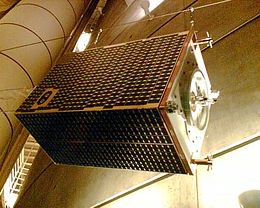Ørsted (satellite)
 Model of the Ørsted Satellite in the Tycho Brahe Planetarium | |
| Mission type | Earth observation |
|---|---|
| Operator | Danish Meteorological Institute |
| COSPAR ID | 1999-008B |
| SATCAT no. | 25635 |
| Mission duration | 25 years, 8 months and 24 days |
| Spacecraft properties | |
| Manufacturer | Computer Resources International |
| Launch mass | 61 kg (134 lb) |
| Dry mass | 50 kg (110 lb) |
| Dimensions | 34x45x72 cm (and an 8 m boom) |
| Power | 54.0 W (nominal) |
| Start of mission | |
| Launch date | 23 February 1999, 10:29:55 UTC |
| Rocket | Delta II 7920-10 D267 |
| Launch site | Vandenberg SLC-2W |
| Contractor | Boeing |
| Orbital parameters | |
| Reference system | Geocentric |
| Regime | Low Earth (near–sun synchronous) |
| Semi-major axis | 7,111.179 km (4,418.682 mi) |
| Eccentricity | 0.0141189 |
| Perigee altitude | 632.6 km (393.1 mi) |
| Apogee altitude | 833.4 km (517.9 mi) |
| Inclination | 96.4421 degrees |
| Period | 99.5 minutes |
| RAAN | 173.2395 degrees |
| Argument of perigee | 10.0389 degrees |
| Mean anomaly | 29.8678 degrees |
| Mean motion | 14.477406 |
| Epoch | 14 December 2013, 14:18:37 UTC[1][2] |
Ørsted is Denmark's first satellite, named after Hans Christian Ørsted (1777–1851), a Danish physicist and professor at the University of Copenhagen. It is in an almost-sun synchronous low Earth orbit.
After more than seventeen years in orbit, the Ørsted satellite is still operational, and continues to downlink accurate measurements of the Earth's magnetic field. Ørsted was constructed by a team of Danish space companies, of which CRI was prime contractor. CRI was acquired by Terma A/S before Ørsted was launched, and the daily operations are run jointly by Terma A/S and the Danish Meteorological Institute.
In 2010, Ørsted passed within 500 meters of debris from the 2009 satellite collision but suffered no damage.[3]
Ørsted was the first in a planned sequence of microsatellites to be flown under the now discontinued Danish Small Satellite Programme.
Mission objectives
The main scientific objective of the spacecraft was to map the Earth's magnetic field and collect data to determine changes occurring in it.
Based on data from the Ørsted satellite, researchers from the Danish Space Research Institute concluded that the Earth's magnetic poles are moving, and that the speed with which they are moving has been increasing for the past few years. This apparent acceleration indicates that the Earth's magnetic field might be in the process of reversing, which could have serious consequences for land-based biological life.
The results have been published in several prominent scientific journals, and printed on the cover pages of Geophysical Research Letters,[4] Nature,[5] and Eos.[6]
Instruments
The primary scientific instruments on the Ørsted satellite are:
- An Overhauser magnetometer provides extremely accurate measurements of the strength of the geomagnetic field. The Overhauser magnetometer is situated at the end of an 8 meter long boom, in order to minimize disturbances from the satellite's electrical systems.
- A CSC fluxgate vector magnetometer, used to measure the strength and direction of the geomagnetic field. The magnetometer is situated somewhat closer to the satellite body in the so-called "gondola", together with
- A star tracker developed by the Danish Space Research Institute, to determine the orientation of the satellite.[7]
The other three instruments are located in the main body of the satellite:
- The Charged Particle Detector, used to measure the flux of fast electrons, protons and alpha particles around the satellite.
- A BlackJack GPS receiver, developed by NASA's Jet Propulsion Laboratory and used to accurately determine the satellite's position; it can also be used to monitor the atmospheric pressure, temperature and humidity profile on the path between Ørsted and GPS satellites through atmospheric occultation.[8]
- A Trimble TANS GPS receiver, also used to determine the satellite's position, as a backup to the BlackJack.
See also
References
- ^ http://www.calsky.com/observer/tle.cgi?satid=99008B&tdt=2456641.33063657
- ^ Peat, Chris (5 December 2013). "Orsted - Orbit". Heavens Above. Retrieved 6 December 2013.
- ^ terma.com Archived 2011-07-16 at the Wayback Machine
- ^ Purucker, M., Langlais, B., Olsen, N., Hulot, G. & Mandea, M.: The southern edge of cratonic North America: Evidence from new satellite magnetometer observations, Geophys.Res.Lett., 29(15), 8000, doi:10.1029/2001GL013645, 2002 [part of a special issue on results from the Ørsted satellite. Plate 3 from this paper is the cover of a special Ørsted issue on August 1, 2002 (Issue #15).]
- ^ Hulot, G., Eymin, C., Langlais, B., Mandea, M. & Olsen, N.: Small-scale structure of the geodynamo inferred from Oersted and Magsat satellite data, Nature, Volume 416, Issue 6881, pp. 620-623 (April 2002)
- ^ Neubert, T., Mandea, M., Hulot, G., von Frese, R., Primdahl, F., Jørgensen, J.L., Friis-Christensen, E., Stauning, P., Olsen, N. & Risbo, T.: Ørsted Satellite Captures High-Precision Geomagnetic Field Data, EOS, Vol. 82, No. 7, p. 81, 87, and 88, Feb. 13, 2001
- ^ Oxborrow, Carol Anne (13 January 2015). "Stellar navigation - DTU Space". Retrieved 16 July 2017.
- ^ Montenbruck, O; Garcia-Fernandez, M; Williams, J (2006). "Performance comparison of semicodeless GPS receivers for LEO satellites". GPS Solutions. 10 (4). Springer-Verlag: 249–261. doi:10.1007/s10291-006-0025-9. Retrieved 2014-04-15.
